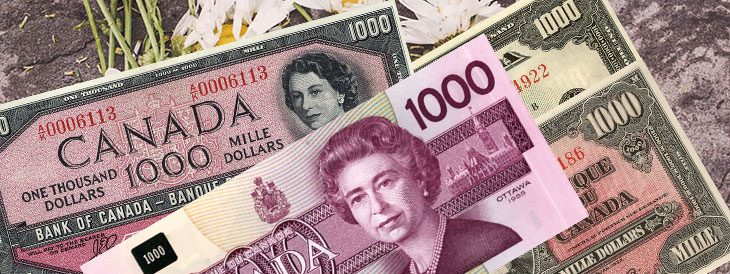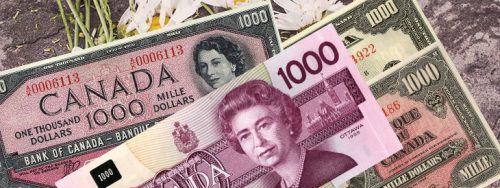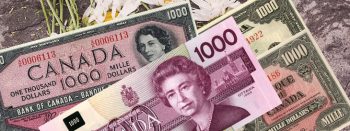Last updated on August 26th, 2025 at 10:28 am
Last Updated on August 26, 2025 Posted by Colonial Acres Coins
When it comes to Canadian paper money, it is no secret that the Royal Canadian Mint is one of the most technologically advanced and creative minting institutions on the planet. Over the course of its long existence, it has expertly crafted millions of interesting coins and paper banknotes. Many of them are still in circulation today, while an almost equal number survive as belongings of many coin collectors around the world. Certainly one of the more intriguing specimens of paper banknotes is the $1,000 note. Here is everything you need to know about it.
The $1,000 Up Close and Personal
The $1,000 bill was nicknamed “Pinkie” because of its reddish-purple hue. It has been in circulation since as early as 1935 and features a portrait of the Queen on the front. At the back, there is a pair of pine grosbeaks. According to estimates from the Bank of Canada, the average $1,000 bill has a lifespan of around 13 years. Also according to the Bank of Canada, even though the bill was no longer issued starting in 2000, there are still hundreds of thousands of these notes floating around. Estimates from the same institution put the total value of these bills at $1,101,782,084.
What This Means For $1,000 Owners
Essentially, any $1,000 bills you may have stashed away for a rainy day will no longer be considered royal tender due to the fact that the Bank of Canada’s decision that it is finally time to push older currency out of circulation for good. What this means is that the $1,000 note – in addition to $500, $25, $2 and $1 notes – will no longer be able to be used in commercial transactions, or in legal terms, “for paying debts.” The reason for such a move is the fact that it is much more difficult to reproduce modern polymer bills. Additionally, the new bills incorporate several security features that the old ones do not possess, making them more resistant to counterfeiting as well as more durable in daily handling.
Why Was This Bill a Non-Favourite of the RCMP?
The simplest way to answer this question is to say that this was the case because it was a favourite among money launderers. Organized crime found the bill extremely attractive for the simple reason that it allowed a single person to carry tens of thousands of dollars in a single envelope everywhere they went. Additionally, not only was the bill desired by criminals for allowing them to carry their earnings around, but the same applied to hide large quantities of money away from the eyes of the authorities. Compared to the $100 bill, which is the next largest denomination, stacks of cash compiled from $1,000 bills were lighter and took up much less space, making them incredibly practical to use during various illegal acts such as drug deals.
Interested in Learning More and Adding This Note to Your Collection? Go to Colonial Acres
Colonial Acres Coins has been in the numismatics business for well over two decades and has become a highly reputable dealer and overall source of industry knowledge and information during that time. This makes us the premier location to visit whether you’re looking to know more about mysterious Canadian paper money or add interesting and rare pieces to your collection. The same applies to the $1,000 bill, so head down to Colonial Acres today if you want to learn more about this unique bill and enrich your collection with it.




